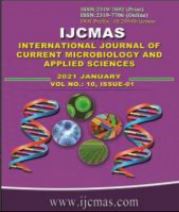


 National Academy of Agricultural Sciences (NAAS)
National Academy of Agricultural Sciences (NAAS)

|
PRINT ISSN : 2319-7692
Online ISSN : 2319-7706 Issues : 12 per year Publisher : Excellent Publishers Email : editorijcmas@gmail.com / submit@ijcmas.com Editor-in-chief: Dr.M.Prakash Index Copernicus ICV 2018: 95.39 NAAS RATING 2020: 5.38 |
The present study was carried out to assess the intranasal features and upper air way abnormalities in brachycephalic dogs exhibiting symptoms of brachycephalicair way syndrome (BAS). The study group included the dogs presented with BAS to Madras Veterinary College Teaching Hospital (MVCTH). The dogs were subjected to adetailed clinical examination and diagnostic tests which included complete blood count(CBC), serum biochemical analysis, electrocardiography (ECG) , Echocardiography , Radiography prior to Computed tomography (CT). CT was done under general anesthesia with informed consent of the owner. All the dogs were preanesthetized with butorphanol@0.2/kg body weight and diazepam @ 0.25-0.5 /kg body weight. General anesthesia was induced with Propofol @ 3/kg body weight, intubated and maintained with 2.5% isoflurane. The dogs were positioned in sternal recumbency with hard palate parallel to the scanning table. CT scan was carried out with slice thickness of 1mm, the tube rotation time was 0.5s, with 1mm image slice thickness, kvp 100, mAs 150.The images were acquired in bone and soft tissue window(Bone: window width 3500HU, window level 1500HU, soft tissue window width350HU, and window level 50HU. The CT images showed intranasal abnormalities like deviated nasal septum in all pugs, aberrant turbinate extending into the nasopharyngeal meatus, compared to normocephalic dogs. The soft palate length and thickness were also increased in brachycephalic dog breeds. The hard palate was also longer in brachycephalic dogs compared to the total length of the nose in brachycephalic and normocephalic dog breeds.
 |
 |
 |
 |
 |